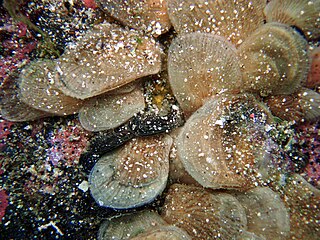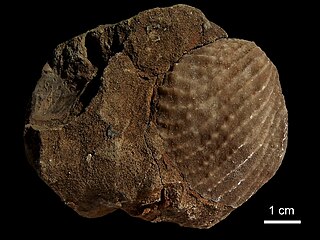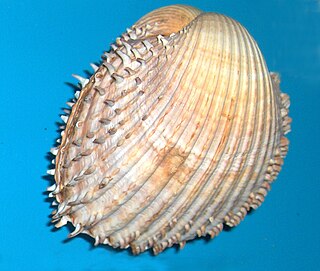
Gryphaea, one of the genera known as devil's toenails, is a genus of extinct oysters, marine bivalve mollusks in the family Gryphaeidae.

Muricidae is a large and varied taxonomic family of small to large predatory sea snails, marine gastropod mollusks, commonly known as murex snails or rock snails. With about 1,600 living species, the Muricidae represent almost 10% of the Neogastropoda. Additionally, 1,200 fossil species have been recognized. Numerous subfamilies are recognized, although experts disagree about the subfamily divisions and the definitions of the genera. Many muricids have unusual shells which are considered attractive by shell collectors and by interior designers.

Lithophaga, the date mussels, are a genus of medium-sized marine bivalve molluscs in the family Mytilidae. Some of the earliest fossil Lithophaga shells have been found in Mesozoic rocks from the Alps and from Vancouver Island.

The Cryptodonta are a nearly-extinct subclass of the bivalves. It contains a single extant order, Solemyida, while the Praecardiida are known only from fossils.

The Plicatulidae are a family of saltwater clams, marine bivalve mollusks, known commonly as kitten's paws or kittenpaws. These bivalves are related to oysters and scallops. The family has a single living genus, Plicatula, with a second, Harpax known from fossils.

Isognomon is a genus of marine bivalve mollusks which is related to the pearl oysters.

Claraia is an extinct genus of scallop-like bivalve molluscs that lived from the Capitanian stage of the Late Permian to the Anisian stage of the Middle Triassic, 266-237 million years ago. Fossils have been found worldwide in North America, Europe, Asia, Africa, and Australia. These are common fossils subsequent to the Permian-Triassic boundary, suggesting that the genus experienced rapid diversification during and after the Permian–Triassic extinction event, around 251.4 million years ago.

Juliidae, common name the bivalved gastropods, is a family of minute sea snails, marine gastropod mollusks or micromollusks in the superfamily Oxynooidea, an opisthobranch group.

Fordilla is an extinct genus of early bivalves, one of two genera in the extinct family Fordillidae. The genus is known solely from Early Cambrian fossils found in North America, Greenland, Europe, the Middle East, and Asia. The genus currently contains three described species, Fordilla germanica, Fordilla sibirica, and the type species Fordilla troyensis.

Myophorella is a genus of fossil saltwater clams, marine bivalve mollusks in the family Trigoniidae. These bivalves are sometimes preserved with mineralized soft tissue.
Pojetaia is an extinct genus of early bivalves, one of two genera in the extinct family Fordillidae. The genus is known solely from Early to Middle Cambrian fossils found in North America, Greenland, Europe, North Africa, Asia, and Australia. The genus currently contains two accepted species, Pojetaia runnegari, the type species, and Pojetaia sarhroensis, though up to seven species have been proposed. The genera Buluniella, Jellia, and Oryzoconcha are all considered synonyms of Pojetaia.
Camya is an extinct genus of early bivalve and is the only genus in the extinct family Camyidae. The genus is known solely from early Middle Cambrian fossils found in Europe. The genus currently contains a solitary accepted species, Camya asy.
Tuarangia is a Cambrian shelly fossil interpreted as an early bivalve, though alternative classifications have been proposed and its systematic position remains controversial. It is the only genus in the extinct family Tuarangiidae and order Tuarangiida. The genus is known solely from Middle to Late Cambrian fossils found in Europe and New Zealand. The genus currently contains two accepted species, Tuarangia gravgaerdensis and the type species Tuarangia paparua.
Kuphus is a genus of shipworms, marine bivalve molluscs in the family Teredinidae. While there are four extinct species in the genus, the only extant species is Kuphus polythalamius. It is the longest bivalve mollusc in the world, where the only known permanent natural habitat is Kalamansig, Sultan Kudarat in the Philippines.
Hemiconcavodonta is an extinct genus of bivalve in the extinct family Praenuculidae. The genus is one of three genera in the subfamily Concavodontinae. Hemiconcavodonta is known solely from late Ordovician, Caradoc epoch, fossils found in South America. The genus currently contains a single accepted species, Hemiconcavodonta minuta.
Similodonta is an extinct genus of early bivalve in the extinct family Praenuculidae. The genus is one of eleven genera in the subfamily Praenuculinae. Similodonta is known from Middle Ordovician through Middle Silurian fossils found in Europe and North America. The genus currently contains eight accepted species, Similodonta ceryx, Similodonta collina, Similodonta djupvikensis, Similodonta magna, Similodonta recurva, Similodonta spjeldnaesi, Similodonta wahli and the type species Similodonta similis.

Acanthocardia is a genus of saltwater clams, marine bivalve molluscs in the family Cardiidae. Like most other bivalves, these mollusks are suspension feeders. This genus is present from the Upper Oligocene to the Recent.

Plagiostoma is a genus of fossil saltwater clams, marine bivalve mollusks in the family Limidae, the file clams.

Actinoceramus is an extinct genus of fossil saltwater clams, marine pteriomorphian bivalve molluscs. These bivalves were facultatively mobile infaunal suspension feeders.

Cremnoceramus is an extinct genus of fossil marine pteriomorphian bivalves that superficially resembled the related winged pearly oysters of the extant genus Pteria. They lived from the Turonian to the Maastrichtian of the Late Cretaceous.














